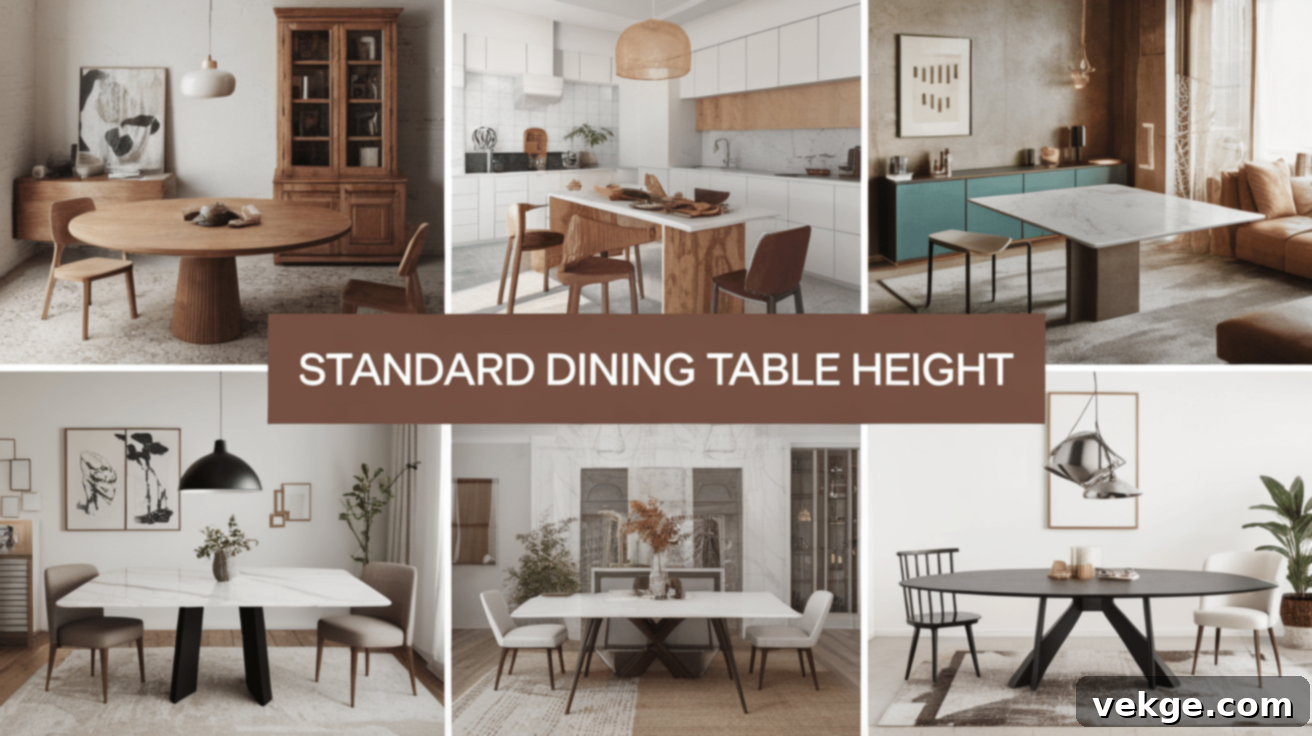The Ultimate Guide to Dining Table Heights: Finding Your Perfect Fit for Comfort & Style
When furnishing or upgrading your dining space, one of the most crucial yet often overlooked factors is the dining table height. It’s not just about aesthetics; the right height profoundly impacts comfort, functionality, and the overall dining experience. A table that is too high or too low can lead to awkward posture, discomfort, and even diminish the enjoyment of meals shared with family and friends.
The industry standard for dining table height typically ranges between 28 to 30 inches from the floor to the tabletop. This specific range has been established to accommodate the average adult comfortably, allowing for proper legroom and a natural arm position while eating. However, this “standard” isn’t a one-size-fits-all solution, as individual preferences, chair dimensions, and the intended use of the dining area all play significant roles in determining the ideal setup.
In this comprehensive guide, we’ll delve into everything you need to know about dining table heights. We’ll explore the standard dimensions, explain why precise measurements matter, and walk you through various table types and their corresponding heights. Whether you’re creating a cozy breakfast nook, a formal dining room, or a versatile kitchen island, this resource will empower you to make an informed decision, ensuring your dining space is both beautiful and ergonomically sound.
What Is the Standard Dining Table Height and Why Does It Matter?

As previously mentioned, the universally recognized standard dining table height typically falls between 28 and 30 inches (approximately 71 to 76 cm). This measurement is not arbitrary; it’s a carefully considered range designed to promote comfortable seating for the majority of adults when paired with standard dining chairs. At this height, most people can sit with their feet flat on the floor, their knees at a comfortable angle, and their forearms resting naturally on the table’s surface without strain.
This standard height is ideal for several reasons:
- Ergonomics: It allows for good posture, reducing the likelihood of back or neck strain during long meals.
- Compatibility: It is perfectly suited for standard dining chairs, which typically have a seat height of 17 to 19 inches.
- Versatility: It accommodates a wide range of activities, from everyday family meals to more formal dinner parties and even homework sessions.
However, it’s crucial to acknowledge that individual body types vary significantly. Taller individuals might find tables at the higher end of the standard range (closer to 30 inches) or even counter-height tables more comfortable for ample legroom. Conversely, shorter individuals may prefer a table closer to 28 inches or benefit from cushions to achieve optimal comfort. Understanding these nuances is key to selecting a table that truly meets your personal comfort needs.
How to Accurately Measure Dining Table Height
Measuring your dining table’s height, or the height of a potential new table, is a straightforward process that is essential for ensuring a harmonious and comfortable dining setup. Here’s a step-by-step guide to get it right:
- Gather Your Tools: You’ll need a reliable tape measure or a sturdy ruler for accurate readings.
- Measure from the Floor to the Tabletop: Place one end of your tape measure on the floor directly beneath the table. Extend the tape measure straight up to the very top surface of the tabletop. This measurement, in inches or centimeters, is your table’s height. Be sure to measure to the absolute top, not just to the bottom of the table apron (the wooden frame just under the tabletop) if present.
- Consider the Table Apron (If Applicable): If your table has an apron, also measure the distance from the floor to the bottom edge of this apron. This “apron height” is critical because it dictates how much clearance your chair armrests (if any) and your legs will have.
- Measure Chair Seat Heights: Once you have your table height, you must measure your dining chairs. Place the tape measure on the floor and measure straight up to the top of the chair’s seat. Standard dining chair seat heights typically range from 17 to 19 inches. If your chairs have armrests, also measure the height of the armrests from the floor to ensure they can tuck neatly under the table apron.
Taking these precise measurements will help you visualize how a dining table and its accompanying chairs will fit together, preventing costly mistakes and ensuring a comfortable dining experience for everyone.
The Crucial Link Between Chair Height and Dining Comfort
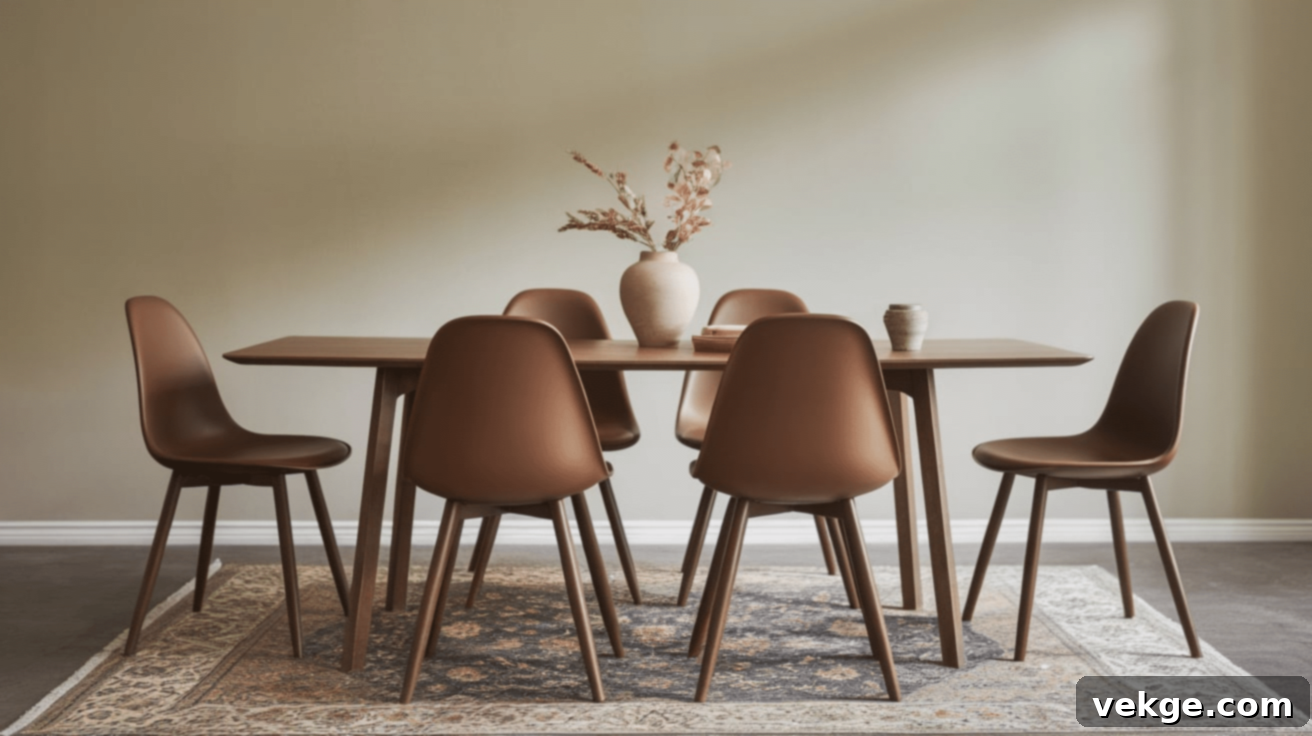
While the table’s height is fundamental, the height of your dining chairs is equally, if not more, critical for achieving true dining comfort. The synergy between these two components creates the ergonomic foundation of your dining space. As mentioned, typical dining chair seat heights fall between 17 to 19 inches from the floor.
The golden rule for comfortable dining is to maintain an adequate gap between the top of the chair’s seat and the underside of the table (or the table’s apron). This ideal clearance is generally about 10 to 12 inches. This specific range provides ample room for:
- Legroom: Allowing diners to comfortably cross their legs, shift positions, and avoid bumping their knees.
- Maneuverability: Ensuring chairs can be easily pulled in and out, and that individuals can get up from or sit down at the table without awkward squeezing.
- Posture: Promoting a relaxed, natural arm position on the table surface, which is vital for comfort during prolonged meals.
If the gap is too small (less than 10 inches), diners will feel cramped, struggling with legroom and potentially hitting their knees against the tabletop or apron. If the gap is too large (more than 12 inches), individuals might find themselves reaching uncomfortably or slouching, leading to poor posture and discomfort. When shopping for chairs, always keep the table’s apron height in mind, especially if your chairs have armrests. Some chairs offer adjustable height mechanisms or come with extra cushioning, which can be beneficial for fine-tuning comfort.
Exploring Different Dining Table Standard Heights
While the 28 to 30-inch range defines the standard dining table, the world of dining furniture offers a variety of heights to suit diverse needs, interior styles, and levels of formality. Understanding these different options is key to selecting a table that perfectly aligns with your lifestyle and space.
1. Standard Dining Tables (28 to 30 Inches)

These are the most ubiquitous and traditional dining tables, forming the cornerstone of dining rooms in countless homes. Their universal appeal stems from their proven comfort for most people and their seamless compatibility with standard dining chairs. Standard dining tables are incredibly versatile, making them perfect for a wide array of uses: from daily family meals and children’s homework sessions to elegant holiday feasts and formal dinner parties. They offer a classic, grounded aesthetic that complements both traditional and contemporary interior designs, providing a stable and inviting focal point for gathering.
2. Counter-Height Tables (34 to 36 Inches)

Rising slightly taller than standard dining tables, counter-height tables are typically between 34 to 36 inches, mirroring the height of most kitchen counters and islands. This makes them an excellent choice for modern, casual dining spaces, open-plan living areas, or as an extension of a kitchen island. When paired with specially designed counter-height chairs or stools (with seat heights generally between 24 and 26 inches), they create a relaxed, informal atmosphere. They are ideal for quick breakfasts, casual brunches, or as a convenient spot for guests to gather while food is being prepared. Counter-height tables can also make a room feel more open and less formal, providing a contemporary vibe that many homeowners desire.
3. Bar-Height Tables (40 to 42 Inches)
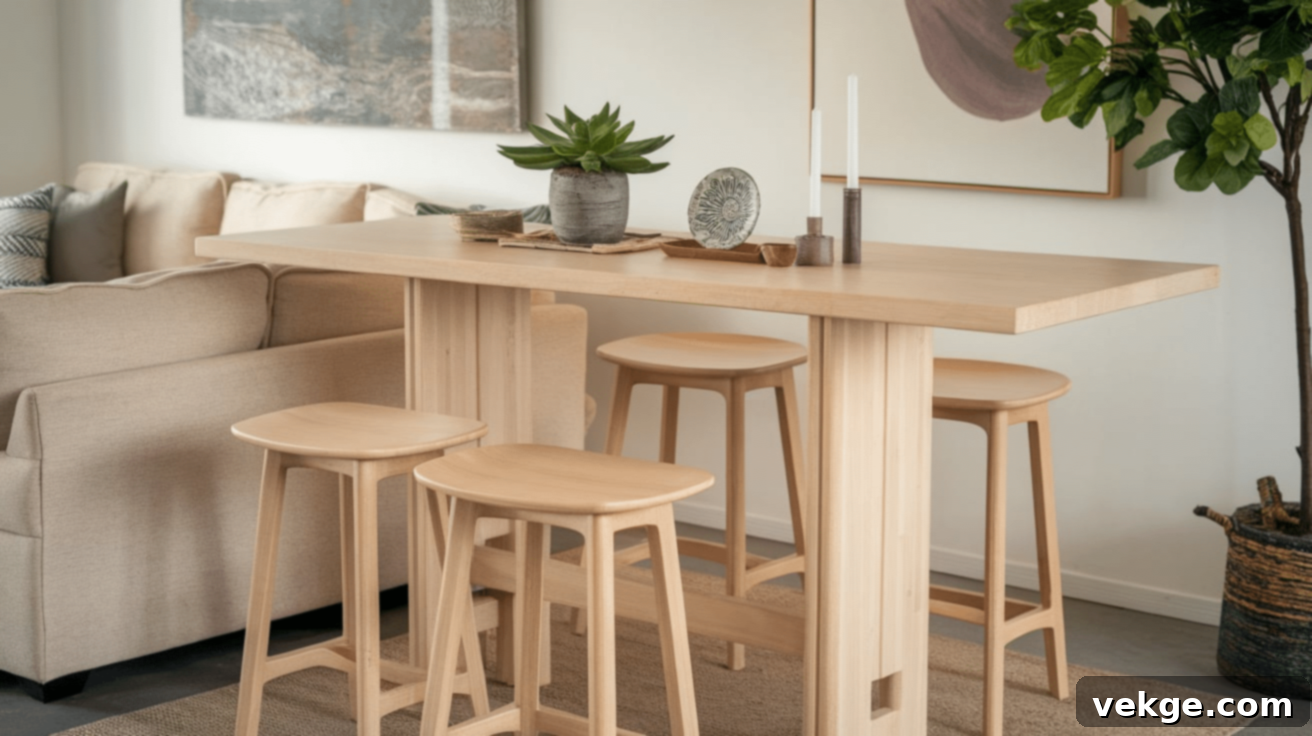
Standing the tallest, bar-height tables typically measure 40 to 42 inches high, requiring bar stools with seat heights around 28 to 30 inches. These tables are often found in home bars, game rooms, or in compact, urban living spaces where a small, vertical dining solution is preferred. They excel at facilitating informal socializing, offering a comfortable standing height for guests who wish to mingle, while also providing a perch for those who prefer to sit. Bar-height tables lend a chic, sophisticated, and often more energetic feel to a room. However, due to their height, they may not be the most comfortable option for very young children, elderly individuals, or for extended, formal meals, as maintaining an upright posture on bar stools for long periods can become tiring for some.
4. Bistro-Height Tables (28 to 30 Inches)
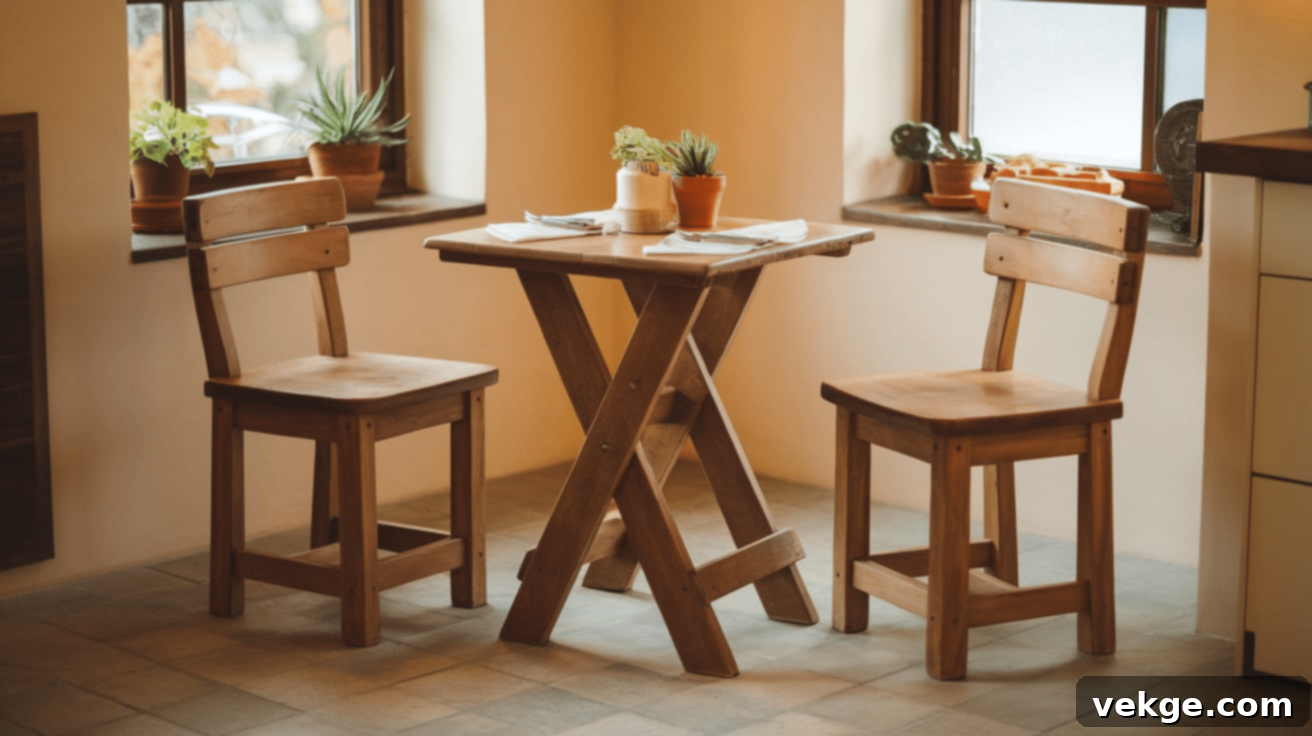
While often sharing the same height range as standard dining tables (28 to 30 inches), bistro tables are distinguished by their typically smaller tabletop dimensions. These compact tables are perfect for intimate settings such as small apartments, breakfast nooks, or a cozy corner in a larger kitchen. Designed to comfortably seat two, and occasionally four, people, bistro tables are fantastic for small-space living, offering a functional dining surface without overwhelming the room. Their compact footprint makes them incredibly versatile for areas where a large dining table would simply not fit, adding a charming and casual touch reminiscent of European cafes.
5. Pedestal Tables (Varies, often 28 to 30 inches)
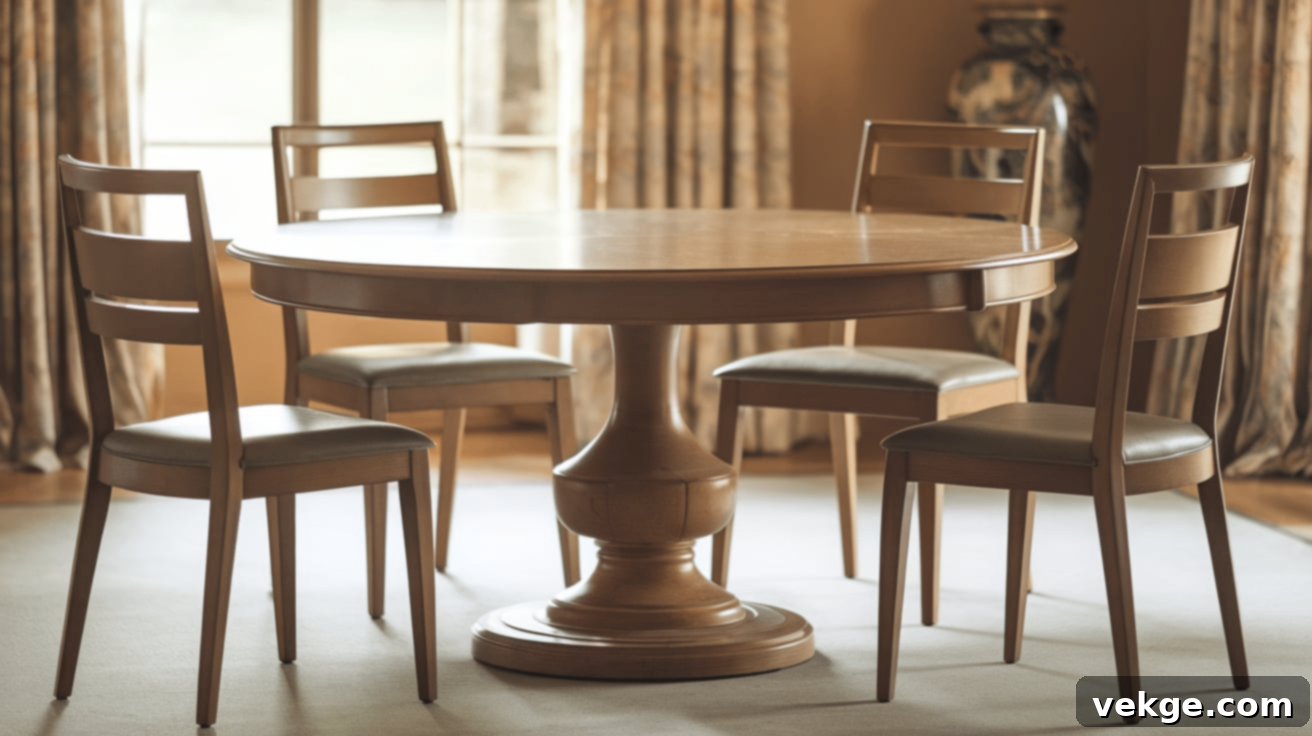
Pedestal tables feature a single, central support base rather than individual legs at each corner. This design offers enhanced seating flexibility, as there are no corner legs to obstruct legroom or chair placement. While their height can vary, most pedestal tables adhere to the standard dining height of 28 to 30 inches. They are a popular choice for those seeking a more elegant, contemporary, or unique aesthetic for their dining room. The absence of multiple legs can make a room feel more open and spacious, and their often sculptural bases can become a significant design statement, adding a sophisticated flair while providing practical utility.
6. Extendable Tables (Varies, often 28 to 30 inches)

Extendable dining tables are marvels of versatility, designed to adapt to varying seating requirements. These tables, which typically maintain a standard height of 28 to 30 inches when not extended, feature leaves or mechanisms that allow them to expand for larger gatherings and contract for everyday use. They are an ingenious solution for homeowners who frequently entertain but wish to conserve space when the table is not in full use. Perfect for families that grow during holidays or for those who host dinner parties, extendable tables offer the best of both worlds: a compact size for daily living and ample space for special occasions, ensuring maximum flexibility without compromising on comfort or style.
7. Picnic Tables (Varies, often 28 to 30 inches)
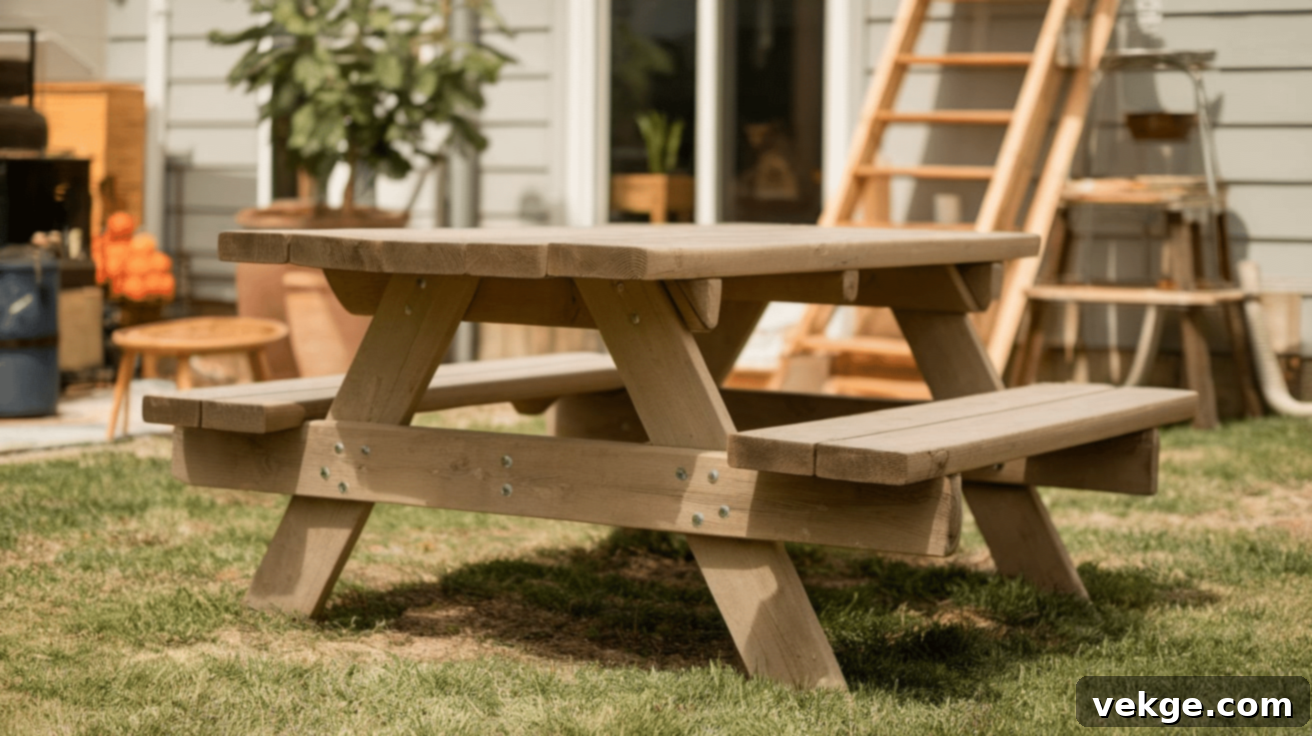
Picnic tables are synonymous with casual, communal dining. While traditionally associated with outdoor settings and parks, indoor versions are increasingly popular, especially in rustic or industrial-themed interiors. Their height typically falls within the 28 to 30-inch standard range, but their defining characteristic is their robust, often wooden construction and integrated bench seating. This built-in seating fosters a highly informal, laid-back atmosphere, encouraging close interaction and a sense of togetherness. Picnic tables are an excellent choice for relaxed family meals, game nights, or as a statement piece in a casual dining area, prioritizing durability and a distinctive, earthy aesthetic.
8. Adjustable Tables (Varies Widely)
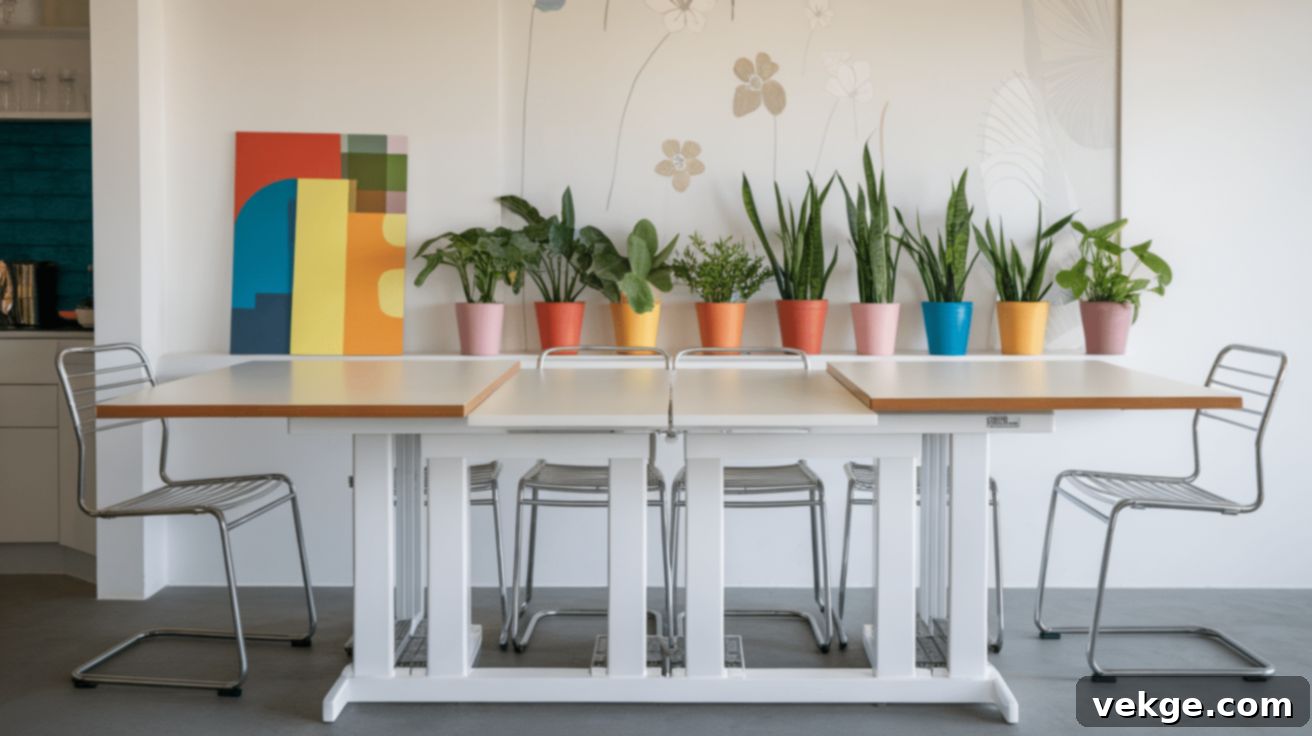
Adjustable height tables represent the pinnacle of flexibility. Equipped with hydraulic or electric mechanisms, these tables can be effortlessly raised or lowered to various heights, transforming from a coffee table to a dining table, or even a standing desk. While more commonly seen in modern office environments, their versatility is increasingly being embraced in residential spaces. For a dining area, an adjustable table offers unparalleled adaptability, allowing users to customize the height for different activities, individual comfort preferences, or even to accommodate both sitting and standing during a casual gathering. They are an innovative solution for dynamic households that require multi-functional furniture and value ergonomic flexibility above all else.
Ultimately, when selecting a dining table, choosing a height that harmonizes with your space, your lifestyle, and the practical needs of your household is paramount. Consider the physical dimensions of your room, the typical number of diners, and the overall ambiance you wish to cultivate in your dining area.
Choosing the Right Height for Your Space: Key Considerations
Selecting the ideal dining table height is a thoughtful process that goes beyond merely picking a style you like. It involves a holistic assessment of your home’s layout, your family’s needs, and your personal preferences. Here are the critical factors to consider:
1. Room Size and Proportions
The dimensions of your dining room or area significantly influence the optimal table height. A standard dining table typically works best in smaller or medium-sized rooms, as its familiar height maintains an intimate feel and prevents the space from feeling overwhelmed. In contrast, for larger, more expansive dining areas or open-concept living spaces, a counter-height or bar-height table can be an excellent choice. Their elevated stature can better fill the vertical space, making the room feel more proportioned and less traditional. They can also serve as a visual divider in an open layout without physically blocking the space.
2. Number of People You Typically Seat
Consider how many people regularly use your dining table and how often you entertain guests. For larger families or those who frequently host big gatherings, a standard-height extendable table or a spacious standard table with ample seating is usually the most practical choice. The stability and accessibility of standard height are generally better for diverse age groups. For smaller families, couples, or individuals living alone, a compact standard table, a bistro table, or even a counter-height table might be a more efficient use of space and still provide sufficient seating for intimate meals.
3. Functionality and Desired Style
Think about the primary function of your dining table. Is it solely for formal meals, or will it double as a workspace, a casual breakfast spot, or a family game table? A standard dining table remains the gold standard for traditional, formal dining experiences, fostering an atmosphere of classic elegance. Counter-height tables, on the other hand, are perfect for creating a more relaxed, casual, and contemporary vibe, often integrating seamlessly with kitchen spaces. Bar-height tables are ideal for an urban, chic aesthetic and serve well for entertaining or quick, informal meals. Your desired aesthetic – be it formal, relaxed, modern, or rustic – should heavily influence your height choice.
4. Personal Preferences and Comfort Needs
Ultimately, personal comfort is paramount. Everyone has unique ergonomic needs and preferred seating postures. Some individuals prefer the classic, upright posture that a standard dining table encourages, finding it most comfortable for long meals. Others might gravitate towards the more relaxed, elevated feel of a counter-height or bar-height setup. If you or members of your family are particularly tall or short, or have specific mobility concerns, testing different table heights (and chair pairings) in person is highly recommended. Pay attention to how your feet, knees, and arms feel to ensure maximum comfort for all users.
Common Mistakes to Avoid When Choosing Dining Table Height
Navigating the world of dining tables can be exciting, but it’s easy to overlook crucial details that can lead to discomfort or regret. Here are some common pitfalls to avoid when selecting your dining table height:
-
Ignoring Chair Height and Clearance: This is perhaps the most frequent mistake. Many people fall in love with a table and purchase it without considering how their existing or new chairs will integrate. Always remember the 10-to-12-inch rule for clearance between the chair seat and the table’s underside. If you have chairs with armrests, measure their height to ensure they can slide completely under the table apron (the frame under the tabletop) for neat storage and comfortable seating. An improperly matched table and chair height is a recipe for an uncomfortable dining experience.
-
Not Measuring Your Space Accurately: It’s tempting to eyeball furniture, but exact measurements are non-negotiable. Not only do you need the table’s dimensions (length, width, and height), but also measure your dining room or area. Ensure there’s at least 36-48 inches of clearance around the table for chairs to be pulled out comfortably and for people to walk around freely. A table that is too large for the room will make the space feel cramped and disproportionate, regardless of its height. Likewise, a table that is too small can feel lost in a large room.
-
Prioritizing Style Over Comfort and Functionality: While the aesthetic appeal of a dining table is important, it should never come at the expense of comfort and practicality. A stunning bar-height table might look fantastic in a showroom, but if it’s too tall for your elderly parents or difficult for your young children to use, it won’t serve its purpose well. Always consider who will be using the table most frequently and for what activities. A table should be a joy to sit at, not a source of discomfort. Strike a balance between a table that enhances your home’s style and one that truly meets the ergonomic needs of its users.
Tips for Customizing Your Dining Area for Optimal Comfort
If you’re facing a situation where your current dining table height isn’t quite right, or if you simply want to enhance comfort and personalization, there are several clever customization strategies you can employ:
- Invest in Adjustable Tables: For ultimate flexibility, consider dining tables with adjustable height mechanisms. These innovative pieces allow you to easily raise or lower the tabletop, adapting to various activities, different users, or even transforming a low coffee table into a functional dining surface. They are an excellent long-term solution if you anticipate diverse needs or are unsure about a fixed height.
- Utilize Seat Cushions and Boosters: If your chairs are too low for your table, adding high-quality seat cushions can effectively raise the sitting height. Look for firm, dense cushions that maintain their loft. For children, booster seats designed specifically for dining chairs can provide the necessary elevation to comfortably reach the table. Cushions also add an extra layer of comfort, especially on hard chair seats, and can introduce color and texture to your dining space.
- Consider Table Risers or Leg Extenders: For a more permanent solution if your table is too low, you might explore table risers or leg extenders. These are sturdy attachments that fit onto the bottom of your table legs to incrementally increase its height. Ensure any risers or extenders are stable, securely attached, and visually harmonious with your table’s design to maintain both safety and aesthetics.
- Stylize with Thoughtful Accessories: While not directly impacting height, well-chosen accessories can significantly enhance comfort and the overall dining experience. Table runners, placemats, and centerpieces can soften the look, reduce noise, and create a more inviting atmosphere. Ensure centerpieces are not so tall that they obstruct conversation across the table. Good lighting, both ambient and task-oriented, also plays a crucial role in creating a comfortable and functional dining environment.
By implementing these customization tips, you can tailor your dining area to perfectly fit your unique space and comfort requirements, transforming it into a truly inviting and functional hub for meals and memories.
Conclusion
Choosing the right dining table height is a pivotal decision that directly impacts the comfort, functionality, and aesthetic harmony of your home. While the standard 28 to 30-inch table serves as an excellent starting point for most households, a truly ideal choice requires a thoughtful consideration of several factors: the dimensions of your room, the number and diverse needs of your family members, your preferred dining style, and personal ergonomic comfort.
By understanding the critical interplay between table height and chair height, specifically aiming for that crucial 10 to 12 inches of clearance, you empower yourself to create a dining space where everyone can sit comfortably and enjoy their meals without strain. Whether your preference leans towards the traditional appeal of a standard table, the casual modernity of a counter-height option, or the chic statement of a bar-height design, making an informed decision will ensure your dining area is not just a place to eat, but a welcoming, functional, and beautiful hub for gathering and creating cherished memories. Take the time to measure, assess, and personalize, and you’ll undoubtedly find the perfect fit for your home.
Frequently Asked Questions About Dining Table Heights
Can I Use a Counter-Height Table for Regular Meals?
Absolutely! Counter-height tables (typically 34 to 36 inches tall) are increasingly popular for everyday meals, especially in open-concept kitchens, casual dining areas, or homes with a modern aesthetic. They offer a relaxed dining experience and can make a space feel more open and integrated. Just ensure you pair them with appropriate counter-height chairs or stools (seat height usually 24-26 inches) for optimal comfort.
How Do I Choose the Right Table Height for My Room?
To choose the right height, consider three main factors: your room size (standard for smaller rooms, counter/bar height for larger, open spaces), the number of people you typically seat (standard is most versatile for diverse groups), and your desired function and style (formal vs. casual, traditional vs. modern). Always prioritize comfort and ensure there’s enough clearance for chairs and movement around the table.
Can I Adjust the Height of My Dining Table?
Yes, some modern dining tables are designed with adjustable height mechanisms, often using hydraulic or electric systems. These versatile tables can be raised or lowered to serve different functions, from coffee table to dining table to standing desk. If you need maximum flexibility or are uncertain about a fixed height, an adjustable table can be an excellent investment.
How Do I Make My Dining Table More Comfortable?
To enhance dining comfort, first ensure your table and chairs are properly matched, maintaining the ideal 10-12 inches of clearance between the chair seat and the tabletop’s underside. If chairs are too low, add quality seat cushions. If the table is too low, consider stable table risers. Also, ensure sufficient space around the table for easy movement, and select chairs with good back support. Thoughtful lighting and table accessories can also contribute to a more inviting and comfortable dining atmosphere.
